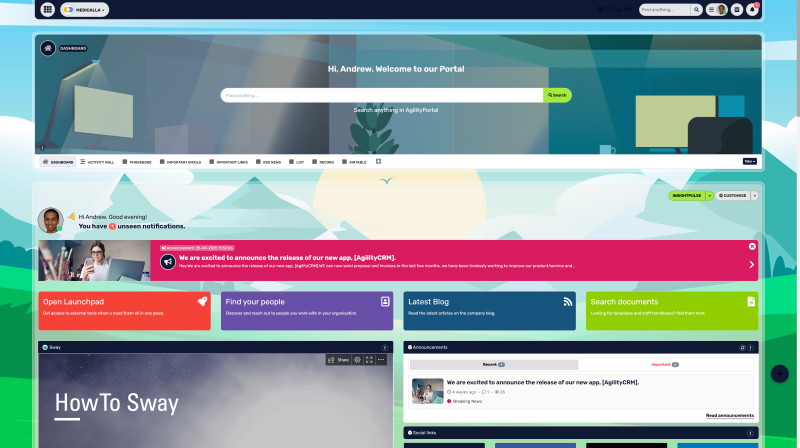Insight Blog
Agility’s perspectives on transforming the employee's experience throughout remote transformation using connected enterprise tools.
13 minutes reading time
(2621 words)
Intranet Case Studies and How to Build a Winning Intranet Business Case for Your Organization
Explore intranet case studies and learn how to build a compelling intranet business case that aligns with your organization’s goals and drives real results.
How Do You Build a Strong Intranet Business Case That Gets Approved?
With 85% of organisations now using some form of digital workplace tool, a well-structured intranet business case has never been more important. Whether you're just starting your intranet journey or looking to upgrade your current platform, presenting a clear, compelling case to stakeholders is crucial for success.
This guide walks you through the most effective way to build your business case, tailored to your project scope, leadership priorities, and decision-making process.
It also includes a practical template to help you get started, using insights from real-world intranet case studies.
In this guide, you'll discover how to:
- Identify and clearly articulate the core problem or opportunity
- Assess and compare potential solutions based on relevance and impact
- Outline the key benefits and provide a detailed cost analysis
- Develop a well-supported recommendation to guide decision-making
While the structure is based on proven frameworks, every business is unique. You're encouraged to adapt the template to meet your goals and align with your organisation's priorities.
This resource is especially valuable for teams at the early stages of intranet planning, offering clarity, structure, and inspiration from successful case studies.
Where is an intranet used?
Although many modern intranets have evolved with the demands of the digital workplace, their usage can vary widely—from enhancing communication and collaboration to streamlining workflows, managing knowledge, and boosting overall productivity.
Because intranet platforms offer different features and configurations, the user experience can differ significantly across organizations. To truly understand how an intranet functions in practice, it's important to evaluate enterprise intranet solutions based on their specific capabilities.
These real-world scenarios provide a clearer picture of what a well-implemented intranet looks like—and how it can deliver measurable value to your business.
Read this article:
Intranet Design Principles – A Complete Guide To Intranet Portal Design
Intranet Design Principles – A Complete Guide To Intranet Portal Design
Why You Need a Business Case Before Pitching a New Intranet to Leadership
Before presenting the idea of a new intranet to your leadership team or board, building a strong, data-backed intranet business case that clearly aligns with your organization's goals and addresses real operational challenges is essential. Without it, you risk proposing a solution without the strategic clarity needed to gain executive support.
According to Deloitte, companies with strong internal communication are 4.5 times more likely to retain top talent, yet many organizations still suffer from fragmented communication and inefficiencies that hinder growth.
Modern intranets are no longer basic file repositories—they are intelligent, centralized platforms that unify people, tools, and information.
If your organisation is experiencing slow onboarding, duplicated work, or disengaged employees, these are red flags that it may urgently need a new intranet.
Here's what typically signals the need for action:
- Scattered Information – Teams waste time searching across email chains, drives, and apps to find basic documents.
- Siloed Communication – Updates are missed, departments are disconnected, and collaboration suffers.
- Inefficient Onboarding – New hires spend weeks ramping up without a central hub for policies, tools, and training.
- Duplicate Efforts – Lack of shared resources leads to redundant work across teams.
- Security Risks – Sensitive data is shared through unsecured, untracked channels.
- Low Engagement – A fragmented digital environment leads to disengaged employees and weakened company culture.
By developing a compelling business case backed by real pain points and measurable benefits, you'll be equipped to show leadership not just why a modern intranet is needed but also how it will deliver ROI, enhance productivity, and future-proof internal operations.
Alerts
Enter an important message here
Enter an important message here
How to Identify and clearly articulate the core problem or opportunity
One of the most crucial first steps in building an effective intranet business case is identifying and clearly articulating the core problem or opportunity. This sets the foundation for the entire proposal and ensures stakeholders understand the investment's purpose and urgency.
Before pitching a new intranet to executives or board members, you must highlight exactly what's not working, or what could be improved, in your current digital workplace.
Whether you're experiencing communication breakdowns, inefficient workflows, or employee disengagement, these challenges must be framed to align with business goals.
For example, if employees spend too much time searching for documents or struggle to access up-to-date resources, that translates to lost productivity and frustration. Similarly, if your platform lacks integration with essential tools or fails to support remote teams, it can undermine collaboration across departments.
By using data-driven insights, internal feedback, and real-world intranet case studies, you can paint a clear picture of the problem. This approach builds credibility and helps align your proposed solution with broader organisational priorities.
Use the table below to guide this step in your business case, incorporating key terms like how to build an intranet business case, internal communication issues, and intranet planning strategy for visibility and relevance.
| Section | Details |
| Problem/Opportunity Statement | Clearly describe the issue or gap in current operations. Focus on pain points like poor communication, low productivity, or disconnected systems. Example: "Employees spend an average of 3 hours per week searching for internal documents." |
| Who is Affected | Identify the teams, departments, or roles impacted by the problem. Example: HR, IT, new hires, cross-functional teams. |
| Current Challenges | Summarize specific challenges (e.g., information silos, duplicated work, inefficient onboarding, compliance risks). |
| Supporting Data | Include any statistics, internal surveys, or benchmarks that illustrate the scale or cost of the issue. Example: "Internal employee survey showed 62% struggle to find policies easily." |
| Why It Matters Now | Explain the urgency or opportunity (e.g., shift to hybrid work, rapid company growth, increased turnover, compliance requirements). |
| Desired Outcome | Define what success looks like if the problem is solved. Example: "Centralized access to tools, faster onboarding, improved collaboration across teams." |
How to Assess and Compare Intranet Solutions Based on Relevance and Impact
So, after you have identified the core problem or opportunity in your intranet business case, the next critical step is evaluating potential solutions. This part of the proposal shows decision-makers that you've considered multiple options—not just one preferred platform—and have weighed each based on business relevance, impact, cost, and scalability.
Choosing the right intranet solution isn't simply about features; it's about aligning the platform with your organisation's goals, digital maturity, and long-term needs. For example, some companies may need an intranet focused on internal communication and content management, while others require deep integrations, advanced workflows, or mobile-first capabilities for frontline employees.
It is important to build credibility in your proposal by comparing each solution side by side. Consider how each option addresses the specific challenges you've already outlined, and use intranet case studies to support your points. You should also explore platform usability, onboarding effort, vendor support, and total cost of ownership.
Using a structured comparison helps reinforce why your final recommendation is the best fit. Incorporating key search terms like choosing the right intranet, intranet platform comparison, and best intranet solutions for business will also improve content visibility and SEO performance.
Use the table below to organise and present your findings.
| Section | Details |
| Solution Options | List the intranet platforms or strategies you're evaluating (e.g., SharePoint, AgilityPortal, custom-built). |
| Relevance to Business Needs | Explain how each solution addresses the specific problems/opportunities identified earlier. |
| Ease of Implementation | Consider setup complexity, onboarding time, training required, and technical support availability. |
| Integration Capabilities | Assess compatibility with existing tools (e.g., Microsoft 365, Google Workspace, Slack, HR systems). |
| Scalability | Evaluate whether the solution can grow with your organization (users, locations, content volume). |
| Cost Estimate | Provide a rough cost for implementation, licensing, support, and ongoing maintenance. |
| Potential Risks/Challenges | Identify any risks such as lack of adoption, hidden costs, or platform limitations. |
| Overall Impact | Rate the expected impact on productivity, communication, employee experience, and ROI.4o |
Outline the Key Benefits and Provide a Detailed Cost Analysis
Once you've identified the problem and assessed potential solutions, the next vital section of your intranet business case is demonstrating why the investment is worthwhile.
This involves clearly outlining the benefits your organization will gain and supporting them with a detailed cost analysis.
Start by breaking down the tangible and intangible benefits. Tangible benefits are easier to quantify and directly tied to ROI—like time saved, reduced software licensing costs, or improved onboarding efficiency. For example, if employees currently spend 3 hours per week searching for information, a streamlined intranet could cut that in half, leading to significant productivity gains.
Intangible benefits, while harder to measure, are just as impactful.
These include better internal communication, stronger employee engagement, and a more unified company culture—especially important for hybrid and remote teams.
Here are some typical intranet benefits to highlight:
- Reduced time spent searching for documents and resources
- Improved communication and knowledge sharing across departments
- Streamlined employee onboarding and training
- Centralized access to tools and systems
- Enhanced employee engagement and morale
- Better compliance and document version control
- Support for remote and hybrid workforces
After defining the benefits, present a comprehensive cost analysis. This should include:
- Licensing or subscription fees
- Implementation and setup costs
- Training and change management expenses
- Ongoing maintenance and support
- Potential integration costs with third-party tools
Where possible, compare these costs to the estimated savings or gains to show ROI over 6–12–24 months. Framing the intranet as a strategic investment, not just an IT expense, is key to winning board approval.
Including keywords like intranet ROI, business case cost analysis, and benefits of intranet software will also help your content reach decision-makers researching these topics.
How to Develop a Well-Supported Recommendation in Your Intranet Business Case
After evaluating potential solutions, comparing their impact, and outlining the benefits and costs, your intranet business case should conclude with a clear, confident recommendation.
This is your opportunity to bring all findings together and guide decision-makers toward the best course of action—supported by data, logic, and business relevance.
Your recommendation should:
- Reaffirm the problem and the urgency of addressing it
- Summarize why the chosen solution is the best fit—based on business needs, cost-effectiveness, scalability, and ease of implementation
- Reference supporting evidence, such as stakeholder feedback, real-world intranet case studies, and competitor insights
- Project the expected outcomes, including improvements in communication, employee engagement, productivity, and ROI
- Define next steps—what's needed to move forward (e.g., budget approval, timeline, vendor selection)
Here's an example statement:
Based on the analysis, we recommend implementing [Chosen Intranet Solution] as the optimal platform to address our internal communication challenges and operational inefficiencies. This solution aligns with our organizational goals, integrates seamlessly with existing tools, and offers scalability to support future growth. With projected time savings of over 2,000 hours annually and improved employee engagement, the intranet is expected to deliver a strong ROI within the first 12 months. We recommend securing funding in Q3 and beginning rollout in Q4, starting with HR and Communications teams as pilot users.
Crafting a recommendation in this format helps leadership understand not just what you're proposing—but why it makes strategic sense.
For better search visibility, include phrases like recommended intranet solution, intranet rollout plan, and executive summary for intranet business case.
How to Build an Intranet Business Case
A successful intranet isn't just about choosing the right platform—it's about creating a clear, strategic plan that aligns with your business goals and secures stakeholder buy-in.
With AgilityPortal, your intranet becomes a digital workspace that connects employees, simplifies workflows, and supports long-term growth.
Use this actionable guide to build a strong intranet business case that gets approved and delivers real value.
Step 1: Start with a Clear Executive Summary
Action: Summarize your intranet proposal in one page. Highlight the challenges you're solving—like poor internal communication, disconnected tools, or low employee engagement.
Tip: Emphasize outcomes such as productivity gains, streamlined collaboration, and culture-building across remote and hybrid team
Step 2: Define the Project Background
Action: Describe your current digital workplace setup. What tools are being used? Where are the gaps?
Include pain points like:
- Disconnected communication across departments
- Onboarding delays
- Scattered knowledge and outdated resources
- Legacy platforms lacking support or scalability
Step 3: List Digital Workplace Requirements
Action: Outline what your teams need from an intranet—based on feedback and business goals.
Key requirements:
- Centralized knowledge sharing
- Department-based content personalization
- Integrations (e.g., Microsoft 365, Slack)
- Mobile-ready access for remote workers
- Role-based permissions and governance
Step 4: Research the Intranet Marketplace
Action: Compare options to show you've explored viable alternatives.
Compare tools like:
- SharePoint or Google Sites
- Lightweight SaaS tools (e.g., Notion, Confluence)
- Full-service solutions like AgilityPortal (with built-in chat, calendar, docs, LMS, and more)
Step 5: Present Your Proposed Approach
Action: Map out your vision.
- Platform selection criteria
- Target use cases (onboarding hub, HR portal, social feeds)
- Phased rollout plan
- Internal stakeholders and champions
AgilityPortal makes this easy with quick-start templates, role-based access, and modular features that grow with your business.
Step 6: Define How You'll Measure Success
Action: Set clear KPIs tied to business outcomes.
- Time saved finding documents
- Onboarding completion time
- Employee engagement rates
- Reduction in redundant tools and content
AgilityPortal includes built-in analytics to track engagement, usage, and performance over time.
Step 7: Create a Project Plan and Budget
Action: Provide a simple but realistic plan with phases, people, and pricing.
- Project phases (discovery to launch)
- Internal resource needs (IT, HR, Comms)
- Estimated costs (software, implementation, training)
- Risks and backup plans
AgilityPortal's fast deployment and no-code options help keep budgets lean and timelines tight.
Step 8: Plan for Governance
Action: Show how you'll manage and maintain the intranet post-launch.
- Content owners and approvers
- Review cycles and content freshness policies
- Guidelines for publishing
- Long-term stakeholder input
It must support flexible workflows, automated reminders, and access control—ideal for scaling governance.
Step 9: Get Business Case Approval
Action: End with a clear, confident call to action.
- Who needs to approve the proposal?
- What's the approval timeline?
- What ROI, engagement, or cultural improvements will the company gain?
Make it easy to say yes by linking your intranet directly to strategic priorities like employee retention, digital transformation, and operational efficiency.
Download the template
Business-Case-Template-v2
763 kb
Get a free copy of the intranet business case template.
Use this AgilityPortal intranet business case template as you follow along with the guide. It provides a step-by-step approach to clearly presenting the potential business value of an intranet for your organization.
You'll find practical examples from our fictional client "Amira Lewis," who identified key internal challenges, mapped out a structured intranet implementation plan, and outlined the requirements needed to gain stakeholder approval.
Determining If an Intranet Is the Right Fit for Your Organization
As you review different intranet use cases, consider which scenarios closely reflect the challenges your organization is currently facing.
- Are communication gaps slowing down projects?
- Is collaboration across departments inefficient?
- Are employees struggling to find key information or documents?
If you find yourself answering "yes" to any of these, it may be time to explore how an intranet could address those issues. Start by clearly identifying your top priorities—whether it's knowledge sharing, employee engagement, streamlined workflows, or better onboarding—and focus your research on solutions that align with those goals.
When evaluating potential platforms, ask vendors targeted questions about the features your organization truly needs. Ensure the solution is flexible enough to scale with you and customizable enough to support your internal processes. Today's intranet platforms are robust and versatile, offering a wide range of tools designed to solve common workplace challenges.
Ready to see how an intranet could work for you?
Reach out to explore tailored solutions and discover how a modern intranet can support your team's success.
Categories
Blog
(2569)
Business Management
(314)
Employee Engagement
(204)
Digital Transformation
(171)
Intranets
(119)
Growth
(114)
Remote Work
(61)
Sales
(48)
Collaboration
(37)
Culture
(29)
Project management
(29)
Customer Experience
(25)
Knowledge Management
(21)
Leadership
(20)
Comparisons
(5)
Ready to learn more? 👍
One platform to optimize, manage and track all of your teams. Your new digital workplace is a click away. 🚀
Free for 14 days, no credit card required.














